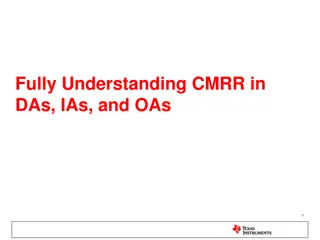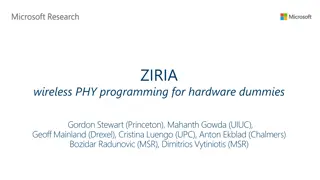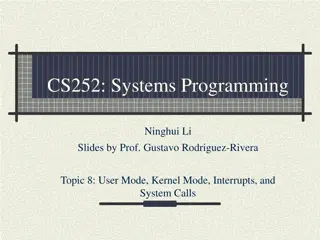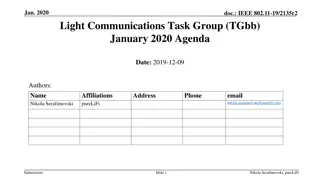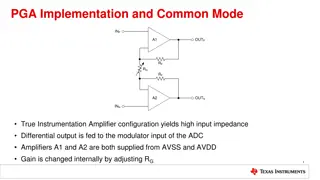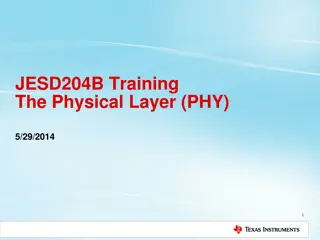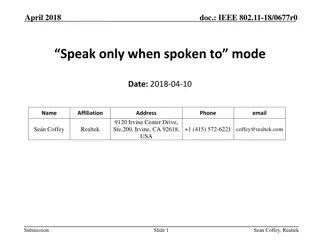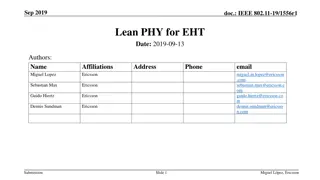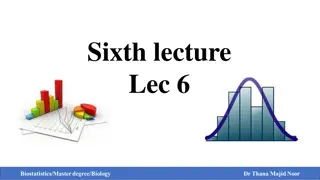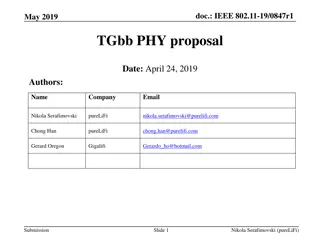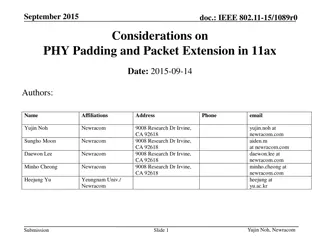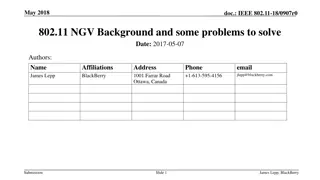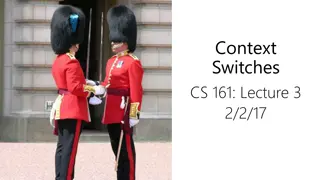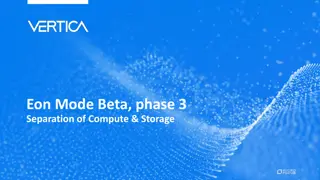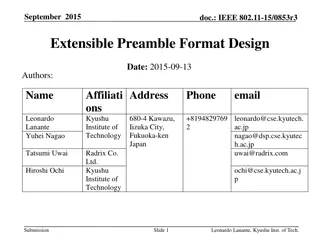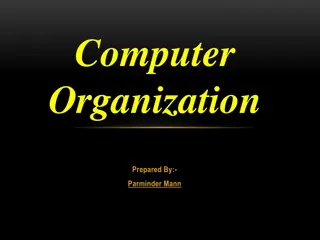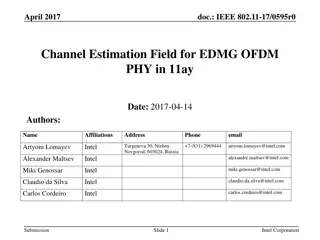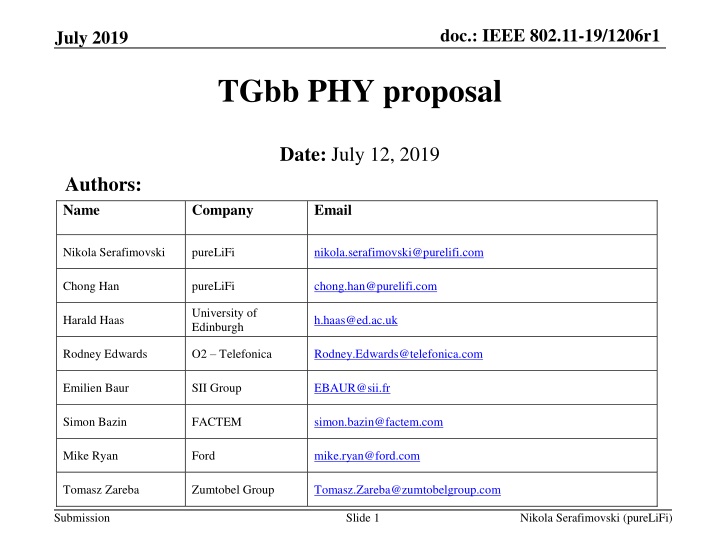
Integration Proposal for IEEE 802.11 LC-Optimized PHY
This presentation discusses a proposal for integrating a PHY layer that enables the application of existing IEEE 802.11 PHY specifications to create a common agreement on mandatory PHY, electrical spectrum masks, and using common spectrum for light communication (LC).
Download Presentation

Please find below an Image/Link to download the presentation.
The content on the website is provided AS IS for your information and personal use only. It may not be sold, licensed, or shared on other websites without obtaining consent from the author. If you encounter any issues during the download, it is possible that the publisher has removed the file from their server.
You are allowed to download the files provided on this website for personal or commercial use, subject to the condition that they are used lawfully. All files are the property of their respective owners.
The content on the website is provided AS IS for your information and personal use only. It may not be sold, licensed, or shared on other websites without obtaining consent from the author.
E N D
Presentation Transcript
doc.: IEEE 802.11-19/1206r1 July 2019 TGbb PHY proposal Date: July 12, 2019 Authors: Name Company Email Nikola Serafimovski pureLiFi nikola.serafimovski@purelifi.com Chong Han pureLiFi chong.han@purelifi.com University of Edinburgh Harald Haas h.haas@ed.ac.uk Rodney Edwards O2 Telefonica Rodney.Edwards@telefonica.com Emilien Baur SII Group EBAUR@sii.fr Simon Bazin FACTEM simon.bazin@factem.com Mike Ryan Ford mike.ryan@ford.com Tomasz Zareba Zumtobel Group Tomasz.Zareba@zumtobelgroup.com Submission Slide 1 Nikola Serafimovski (pureLiFi)
doc.: IEEE 802.11-19/1206r1 July 2019 Abstract This presentation aims to provide a suggestion on the integration of a PHY layer that could enable existing .11 PHY specifications to be applied for LC and create agreement on: - Common-mandatory PHY, - Electrical spectrum masks, and - Common spectrum (light color). Submission Slide 2 Nikola Serafimovski (pureLiFi)
doc.: IEEE 802.11-19/1206r1 July 2019 Introduction TGbb pre-proposal was discussed in doc. 11-19/0388r0 and doc. 11- 19/0847r0. Submission Slide 3 Nikola Serafimovski (pureLiFi)
doc.: IEEE 802.11-19/1206r1 July 2019 Characteristics of LC PHYs LC requires a non-negative and real-valued baseband-signal. Bipolar signals can be turned non-negative by adding a DC- bias before transmission. optical channel + RX DSP TX DSP Driver & LED High- pass Photo- diode DC It is removed by using a high-pass filter before reception. Submission Slide 4 Nikola Serafimovski (pureLiFi)
doc.: IEEE 802.11-19/1206r1 July 2019 Use existing 802.11 PHYs for LC Complex OFDM-baseband signals are real-valued after up- conversion to the carrier frequency fc. Up-con- version Data LED Re(.) CP IFFT fc For LC, one could simply change fcto a low carrier ( low IF ), yielding a real-valued baseband signal. Submission Slide 5 Nikola Serafimovski (pureLiFi)
doc.: IEEE 802.11-19/1206r1 July 2019 Using existing 802.11 PHYs for LC RF frontend up-converts baseband signals onto e.g. fc=2.4 GHz. LC frontend up-converts baseband onto low IF e.g. fc=BW/2 + . is to be agreed depending on signal mask design. This way, any complex-valued baseband signal (i.e. any existing IEEE 802.11 PHY) can be used to facilitate LC. fc=BW/2 + Submission Slide 6 Nikola Serafimovski (pureLiFi)
doc.: IEEE 802.11-19/1206r1 July 2019 Use existing and LC-optimized PHY under 802.11 MAC 802.11 MAC could integrate existing and optimized PHY 802.11 MAC LC-Optimized PHY Existing PHY for LC Use existing 802.11ax PHY as a common, mandatory OFDM PHY. Negotiate the use of the LC-optimized PHY if both devices have that capability. Submission Slide 7 Nikola Serafimovski (pureLiFi)
doc.: IEEE 802.11-19/1206r1 July 2019 Wi-Fi 6 chipsets range Submission Slide 8 Nikola Serafimovski (pureLiFi)
doc.: IEEE 802.11-19/1206r1 July 2019 Wi-Fi 6 chipsets availability TGbb completion Submission Slide 9 Nikola Serafimovski (pureLiFi)
doc.: IEEE 802.11-19/1206r1 July 2019 11ac vs. 11ax MAC comparison IEEE 802.11ac IEEE P802.11ax HCF Yes. Yes. - MU EDCA mode added in order to enhance QoS All BW used. BSS color tag in PHY header. OBSS scan for each PPDU. OBSS - - OBSS scan before setting BSS. Channel switch/selection to implement spatial reuse. The new BSS may select the same primary channel identical to the primary channel of any one of the existing BSSs. STAs decide to Doze. Doze during each TXOP. - - - Power saving - - AP tells STAs to enter power saving modes. OFDMA to increases user data rates and reduces latency. Support large amount of active users. Other benefits Submission Slide 10 Nikola Serafimovski (pureLiFi)
doc.: IEEE 802.11-19/1206r1 July 2019 PROPOSAL: Use 11ax PHY as one of the operating modes for TGbb Straw Poll: 11ax (High efficiency PHY specification) is to be considered as one of the operating modes for TGbb Result (Y/N/A): 17 / 1 / 6 Submission Slide 11 Nikola Serafimovski (pureLiFi)
doc.: IEEE 802.11-19/1206r1 July 2019 Spectrum mask (11ax 20MHz) Submission Slide 12 Nikola Serafimovski (pureLiFi)
doc.: IEEE 802.11-19/1206r1 July 2019 Spectrum mask (11ax 40MHz) Submission Slide 13 Nikola Serafimovski (pureLiFi)
doc.: IEEE 802.11-19/1206r1 July 2019 Spectrum mask (11ax 80MHz) Submission Slide 14 Nikola Serafimovski (pureLiFi)
doc.: IEEE 802.11-19/1206r1 July 2019 Spectrum mask (11ax 160MHz) Submission Slide 15 Nikola Serafimovski (pureLiFi)
doc.: IEEE 802.11-19/1206r1 July 2019 Spectrum mask (11ax 80+80MHz) Submission Slide 16 Nikola Serafimovski (pureLiFi)
doc.: IEEE 802.11-19/1206r1 July 2019 PROPOSAL: Baseband spectrum mask NOT RUN Straw Poll: Should the mandatory baseband spectrum masks for the 802.11 PHY modes as described in Slides 12-16 be accepted for TGbb? Y/N/A Submission Slide 17 Nikola Serafimovski (pureLiFi)
doc.: IEEE 802.11-19/1206r1 July 2019 PROPOSAL: Baseband center frequencies NOT RUN Straw Poll: TGbb should set the mandatory, common-mode centre frequencies as follows: 20 MHz for a 20 MHz baseband signal 40 MHz for a 40 MHz baseband signal 80 MHz for a 80 MHz baseband signal 160 MHz for a 160 MHz baseband signal 80 MHz and 160 MHz for an 80 + 80 MHz baseband signal that would be equivalent to the -28 dBr spectrum mask for the relevant signals. Y/N/A Submission Slide 18 Nikola Serafimovski (pureLiFi)
doc.: IEEE 802.11-19/1206r1 July 2019 PROPOSAL: Wavelength NOT RUN Straw Poll: The mandatory wavelength for the 802.11bb be set to cover 850nm up to 900nm? Y/N/A Submission Slide 19 Nikola Serafimovski (pureLiFi)


